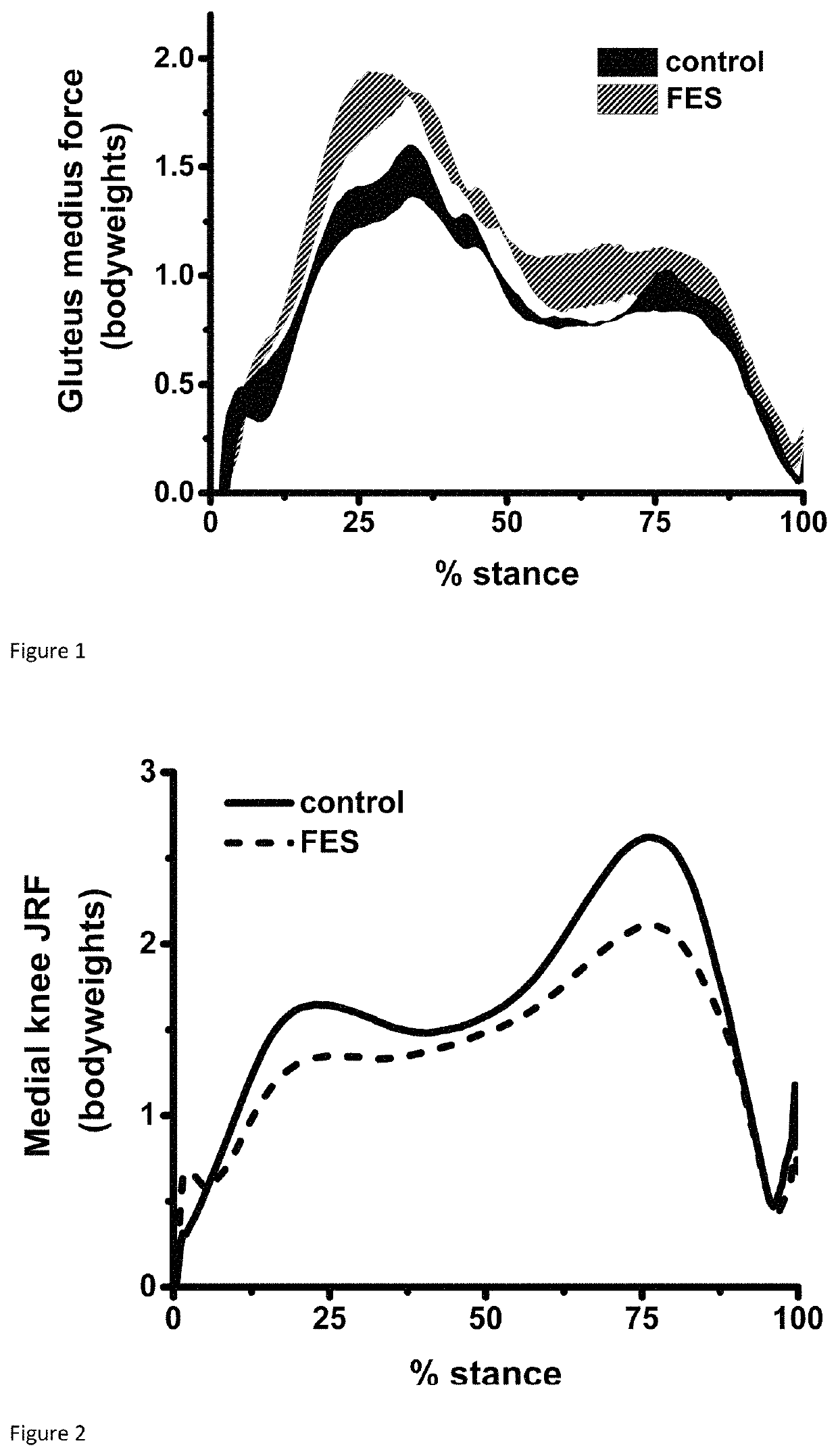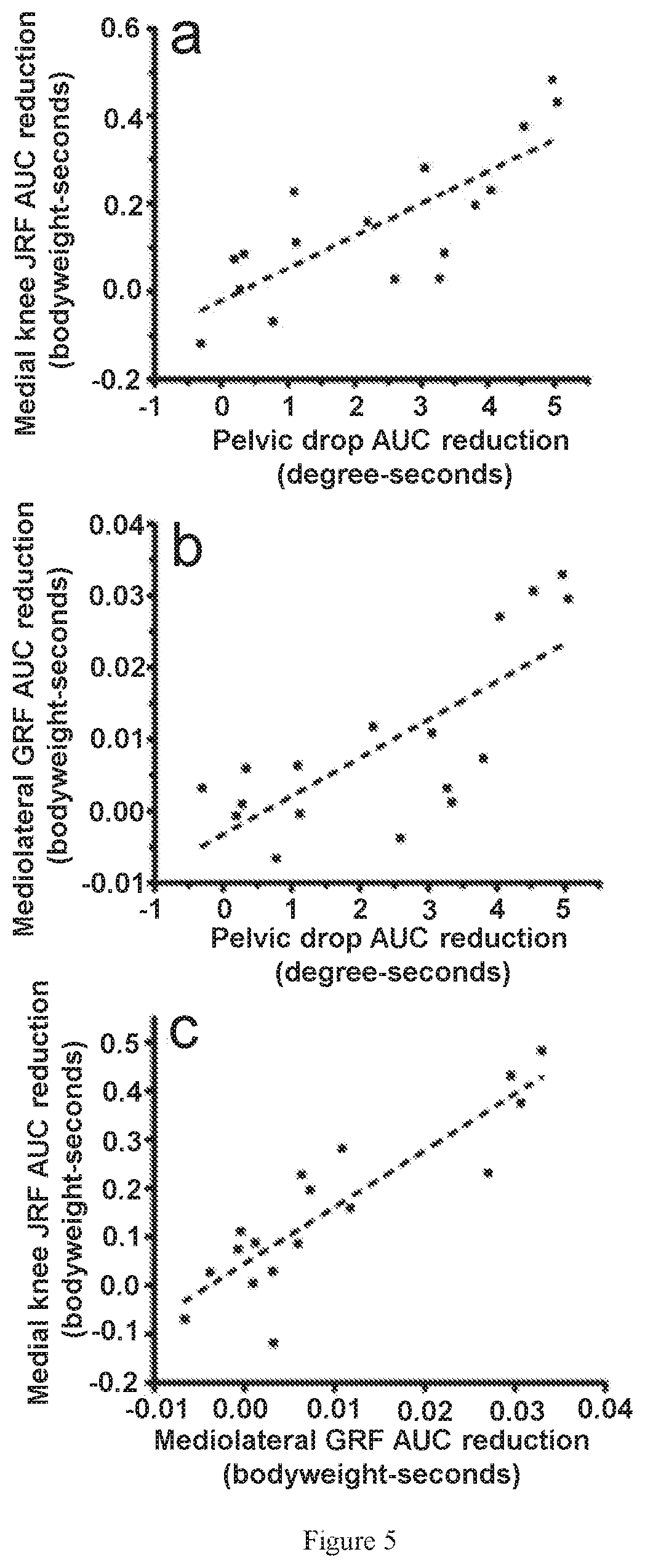Functional electrical stimulation
a functional electrical stimulation and knee technology, applied in the field of knee disorders via functional electrical stimulation, can solve the problems of significant disability in affected patients and instability of the knee, and achieve the effects of specific relevance, and reducing the magnitude of the eam
- Summary
- Abstract
- Description
- Claims
- Application Information
AI Technical Summary
Benefits of technology
Problems solved by technology
Method used
Image
Examples
example 1
FES of the Gluteus Medius During Gait
[0076]The effects of specific muscular augmentation of gluteus medius on the medial knee JRF during level walking were investigated using motion capture and musculoskeletal modelling. Application of FES to gluteus medius facilitated an average reduction in the medial knee JRF AUC of 12.5%.
[0077]Methods
[0078]Motion Capture
[0079]The experimental setup for gait analysis comprised a set of 10 Vicon optoelectronic cameras (Vicon MX system, Vicon Motion Systems Ltd, Oxford, UK) trained on a level walkway with a force plate (Kistler Type 9286AA, Kistler Instrumente AG, Winterthur, Switzerland) at its centre 12 single infrared reflective markers and two 3-marker clusters were used to form a model of lower limb kinematics. For each subject recorded data included a single static trial, with the subject stood motionless in neutral posture, and multiple dynamic trials. During the latter, subjects walked normally across the walkway, taking several steps prior...
example 2
FES of the Biceps Femoris and Gastrocnemius During Gait
[0113]The effects of specific muscular augmentation of the long head of biceps femoris and lateral gastrocnemius on the medial knee JRF during level walking were investigated using motion capture and musculoskeletal modelling. Application of FES to the long head of biceps femoris and lateral gastrocnemius was investigated.
[0114]Methods
[0115]Experimental Data
[0116]Ten healthy subjects (age, 27.4±2.4 years; mass, 67.6±16.2 kg; height, 1.70±0.11 m; 5 males and 5 females) participated in this study and performed four gait tasks: normal walking, long head of biceps femoris (loBF), lateral gastrocnemius (latGAS) and vastus lateralis (VL) stimulated walking.
[0117]For normal walking, the subjects walked 6 trials at a self-selected speed; for FES-assisted walking, the subjects walked 6 trials first with loBF, then with the latGAS and lastly with the VL of the right leg stimulated. The electrode pads were put at the two motor points of th...
example 3
Activation of Biceps Femoris Reduces Tibiofemoral Anterior Shear Force and Tibial Internal Rotation Torque
[0158]This study tested the hypothesis that selective activation of the biceps femoris, one of the hamstrings muscles, can theoretically and practically reduce anterior tibial shear and tibial internal rotation torque at the knee. A combined modelling and experimental approach was taken.
[0159]Physical Experiments
[0160]The experiment was approved by the institutional ethics review board and written informed consent was obtained from all participants. 12 healthy subjects (5 male, 7 female; height 1.67±0.08 m; mass 66.74±16.80 kg; age 26.08±2.29 years) underwent walking activities without and with functional electrical stimulator (FES) electrodes (Odstock 2 Channel Stimulator, Odstock Medical Ltd., UK) placed over the BF. One electrode was placed at the bottom of the BF and one at the centre, with a distance of two hand widths between them. The frequency of the stimulator was set t...
PUM
 Login to View More
Login to View More Abstract
Description
Claims
Application Information
 Login to View More
Login to View More - R&D
- Intellectual Property
- Life Sciences
- Materials
- Tech Scout
- Unparalleled Data Quality
- Higher Quality Content
- 60% Fewer Hallucinations
Browse by: Latest US Patents, China's latest patents, Technical Efficacy Thesaurus, Application Domain, Technology Topic, Popular Technical Reports.
© 2025 PatSnap. All rights reserved.Legal|Privacy policy|Modern Slavery Act Transparency Statement|Sitemap|About US| Contact US: help@patsnap.com



